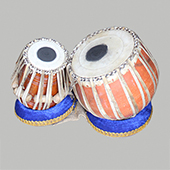Design Resource
Terracotta Dagga - Agartala, Tripura
Tabla Making
by
Terracotta Dagga, a Tabla, is made in Agartala, the capital city of Tripura. By using terracotta as a base, Dagga is being made to get a good base and clear pitch in the hall of musicians. Music has influenced our life from the ancient days, and tradition still follows them. The musical instruments are always used to support music.
The Tabla is an instrument consisting of a pair of drums used in traditional, classical, and popular folk music. The smaller drum, played with the dominant hand, is sometimes called Dayan (literally "right"), dāhina, but is correctly called the "Tabla." The small table is made from a conical piece of mostly teak and rosewood hollowed out to approximately half its total depth. The larger drum, played with the other hand, is called Bayan (literally "left") or sometimes Dagga, Duggi, or Dhama. The Dagga may be made from different kinds of materials. Brass is the most common, copper is more expensive but generally held to be the best, while aluminum and steel are often found in inexpensive models.
The name Tabla likely comes from tabl, the Persian and Arabic word for drum. Generally, in the Northeast region of Bengal clay is used, although not favored for durability. Terracotta is a red clay-based baked ceramic, usually unglazed. Initially, the clay sculptures were dried in the sun after being made. To make them harden they were placed in the ashes of open hearths, and finally, kilns were used, similar to those used for pottery nowadays. It has been a particularly important instrument in Hindustani classical music since the 18th century and remains in use in India, Pakistan, Nepal, Bangladesh, and Sri Lanka.



